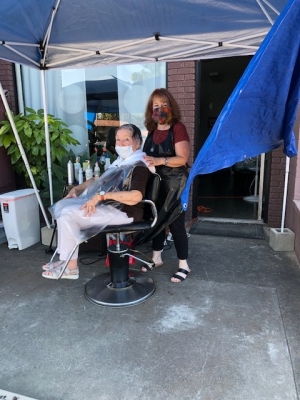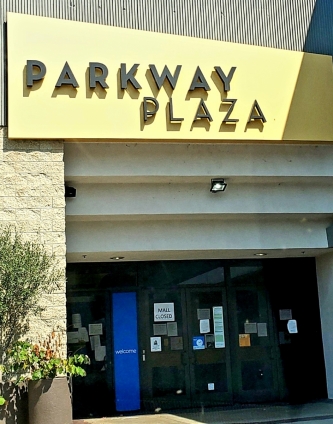
By Miriam Raftery
Photo: Roz Oserin, owner of Prete-a-Porter Salon and Spa, says cutting hair outdoors has been "an adventure" but she looks forward to resuming indoor services starting Monday.
August 29, 2020 (San Diego) – Yesterday, the state announced new rules to allow many businesses and houses of worship to reopen in counties including San Diego, with streamlined new criteria.
Starting Monday, August 31, the new state tiered system allows the following businesses in our region to reopen, with the following requirements:
No capacity limits (though modifications such as masks and 6 feet of social distancing are required)
- Personal care services, such as hair and nail salons and barber shops
- Hotels and other lodging (but fitness centers must be no more than 10% capacity indoors)
The following can reopen at 25% capacity, or with a maximum capacity of 100 people indoors (whichever is less):
- Restaurants for indoor dine-in service
- Places of worship
- Movie theaters
- Museums, zoos and aquariums
These business can reopen indoors with up to 50% capacity:
- All retail
- Shopping malls (with reduced capacity food courts and closed common areas)
The following group will be allowed to open indoors Monday at 10% capacity:
- Indoor operation gyms and fitness centers
These businesses are still limited to outdoors only:
- Wineries
- Family entertainment centers(kart racing, mini golf, batting cages)
- Card rooms
These businesses must remain closed:
- Bars, breweries and distilleries, if no meal is provided
Non-essential offices must continue working remotely.
Professional sports can be open without live audiences.
Capacity limits will make it challenging for many businesses to turn a profit off indoor activities alone, however outdoor activities can continue for any businesses with space and a willingness to offer them. To-go services for businesses such as restaurants can also continue. Some local cities have allowed activities such as fitness classes to be held in public parks.
The state’s new four-tier, color-coded system has been simplified to rely on only two metrics: the daily rate of new cases per 100,000 residents and the seven-day average rate of positive tests. Here are the tiers by which county’s will be assessed:
- Purple or “widespread”: More than 7 new cases per 100,000 and a positive rate of more than 8%
- Red or “substantial”: 4 to 7 new cases per 100,000 and a positive rate between 5% and 8%
- Orange or “moderate”: From one to 3.9 new cases per 100,000 and a positive rate from 2% to 4.9%
- Yellow or “minimal”: Counties with less than one new case per 100,000 and a positive rate less than 2%.
San Diego is currently at 5.8 new cases daily per 100,000 residents and a seven-day positive rate of 3.8%. It makes the red “substantial” category based on the daily new case rate, even though the positive rate is low. If the case rates fall and stay down for 14 days, the county could drop down to the moderate category.
For businesses, there is strong incentive for the county to drop into the moderate category based on the state’s guidelines, which allow for higher capacity occupancy at the lower tiers. For instance, at the “moderate stage,” movie theaters, indoor restaurants and churches could have 50% capacity or 200 people, which ever is less. Fitness centers and gyms could have 25% capacity. Bars and breweries could offer outdoor service and wineries could open inside, at reduced capacity. Non-essential offices could operate again indoors.
At the yellow or “minimal” tier, bars could reopen indoors at 50% capacity, ice skating and roller rinks could reopen, and fitness centers could be at 50% capacity indoors, to cite a few examples.
Currently, San Diego County is the only Southern California not in the highest purple category. Statewide, 38 of California’s counties are in the purple “widespread” category.
Dr. Wilma Wooten, County Public Health Officer, cautioned the public in a press conference Friday, “The County of San Diego is red surrounded by a sea of purple. Keeping up the momentum to stay on track and not go backwards in this new tier system to the purple tier will require that all of us follow the best practices.”
She urged everyone to use masks, wash hands frequently, and maintain social distance to enable San Diego to avoid a surge in cases.
 The state has created a website that explains the specific rules for an extensive list of businesses. The website indicates that a lot has been learned since the pandemic began, such as that the virus spreads more easily indoors, as well as about sanitation procedures and the role of masks and social distancing to help minimize the spread.
The state has created a website that explains the specific rules for an extensive list of businesses. The website indicates that a lot has been learned since the pandemic began, such as that the virus spreads more easily indoors, as well as about sanitation procedures and the role of masks and social distancing to help minimize the spread.
Photo, left by Rebecca Jefferis-Williamson: Interior stores at Parkway Plaza will be able to reopen starting Monday.
Governor Newsom stated in a press conference Friday, “COVID-19 will be with us for a long time and we need to adapt. We must deal with this reality and this fundamental truth until there is a vaccine, until we have the kind of therapeutics that could substantially mitigate the spread and the impact of COVID-19, that we will simply need to adapt our behaviors until that time.”
President Donald Trump has pushed for a vaccine to be developed by year’s end, though some health experts say early next year is a more likely scenario, following safety and effectiveness testing. Vaccines will likely first be made available to healthcare workers and first responders, as well as the most vulnerable individuals, such as patients in nursing homes. As more vaccines are produced, it should become available to the general public.
Supervisor Nathan Fletcher, who leads the county’s task force on the pandemic, expressed concern that too many businesses are being allowed to reopen Monday, possibly causing a new spike in cases.
“While there are some lower risk entities that could safely reopen at this point, what we are doing is very similar to what we did in June with a large segment of indoor operations all opening at the same time,” he said. “This led to a large increase in cases and required new restrictions.”
But he concluded, “Even though I prefer a different path, the decision has been made and I will continue to work tirelessly to help us find a way to slow the spread.”
 Miriam Raftery, editor and founder of East County Magazine, has over 35 years of journalism experience. She has won more than 350 journalism awards from the Society of Professional Journalists, San Diego Press Club, and the American Society of Journalists & Authors. Her honors include the Sol Price Award for responsible journalism and three James Julian awards for public interest reporting from SPJ’s San Diego chapter. She has received top honors for investigative journalism, multicultural reporting, coverage of immigrant and refugee issues, politics, breaking news and more. Thousands of her articles have appeared in national and regional publications.
Miriam Raftery, editor and founder of East County Magazine, has over 35 years of journalism experience. She has won more than 350 journalism awards from the Society of Professional Journalists, San Diego Press Club, and the American Society of Journalists & Authors. Her honors include the Sol Price Award for responsible journalism and three James Julian awards for public interest reporting from SPJ’s San Diego chapter. She has received top honors for investigative journalism, multicultural reporting, coverage of immigrant and refugee issues, politics, breaking news and more. Thousands of her articles have appeared in national and regional publications.
East County Magazine gratefully acknowledges the Facebook Journalism Project for its COVID-19 Relief Fund grant to support our local news reporting including impacts on vulnerable communities during the COVID-19 pandemic. Learn more: #FacebookJournalismProject and https://www.facebook.com/fbjournalismproject/.
You can donate to support our local journalism efforts during the pandemic at https://www.EastCountyMedia.org/donate.










Recent comments